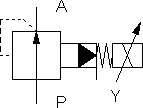Proportional pressure reducing valve, piloted

The pilot operated proportional pressure regulator valve consists of a pilot stage with poppet valve and a main stage with control slide valve. The pressure at connection A acts upon the pilot poppet via a drilling in the control slide valve. The proportional magnet exercises the electrically adjustable counter force with the assistance of a proportional amplifier.
If the pressure at connection A is below the preset value, then the pilot control remains closed. The pressure on both sides of the control slide valve is equal. A spring holds the main stage control slide valve open and the hydraulic fluid flow freely from connection P to connection A.
If the pressure at connection A exceeds the preset value, then the pilot stage opens causing less volumetric flow to flow to connection A. The pressure falls at the throttle valve inside the control slide valve. Thus the pressure at the spring side is lower than the pressure at connection A. Due to the pressure difference, the control slide valve closes so far until the spring force re-establishes an equilibrium of forces. As a result, the flow resistance at the control edge between connections P and A increases and the pressure at connection A sinks.
The control voltage must be between 0 V and 10 V. The minimum nominal pressure defines the opening pressure at the pre stage via the spring force at 0 V. The maximum nominal pressure defines the opening pressure at 10 V. The hydraulic resistance relates to the completely opened main stage leading edge.
Adjustable parameters
Hydraulic resistance: 1e-7 ... 100 MPa*min2/l2 (0.01)
Related Topics
Proportional amplifier, 1-channel
Open-loop and Closed-loop Control by using Continuous Valves

